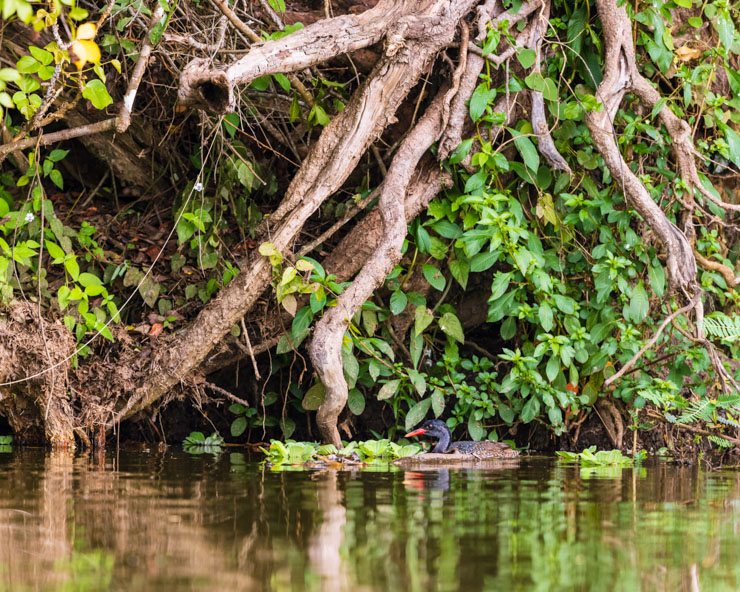
Back in 2023 when I broadcast my glee at seeing for the first time a member of the Heliornithidae family – one that is considered a “nemesis family” by some – I had no idea that I’d eventually grind my way up from one to two of three. But life throws different options and opportunities at you, especially if you are willing to navigate any number of flotillas of irate hippopotami.
Uganda’s Lake Mburo may not be as expansive as some of the other bodies of water in the landlocked African state, but it must be tough living in the shadow of the world’s largest tropical lake anyway. Getting there is straightforward (especially when driven by a capable guide), avoiding the baboons sneaking up to grab your snacks takes a little more spatial awareness. As we waited on the boat ramp, scores of White-rumped Swift careened overhead while Lesser Striped Swallows filled their (relatively) large mouths with piles of flying insects to deposit in the waiting maws of eager young. An Olive-bellied Sunbird slid along the branches of a sprawling shrub at the water’s edge, deftly piercing the bases of flowers that clutched their petals tightly while a Pied Kingfisher purposefully darted from its perch, leaving the entire bough shivering – only to stop a few metres away, hovering thoughtfully.
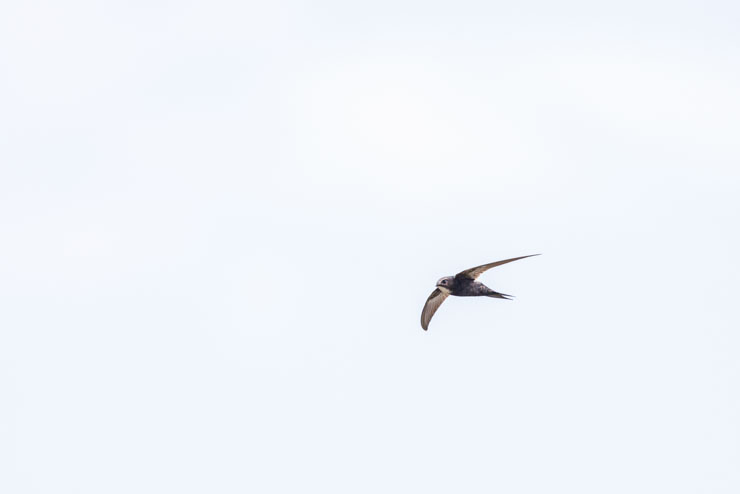
White-rumped Swift
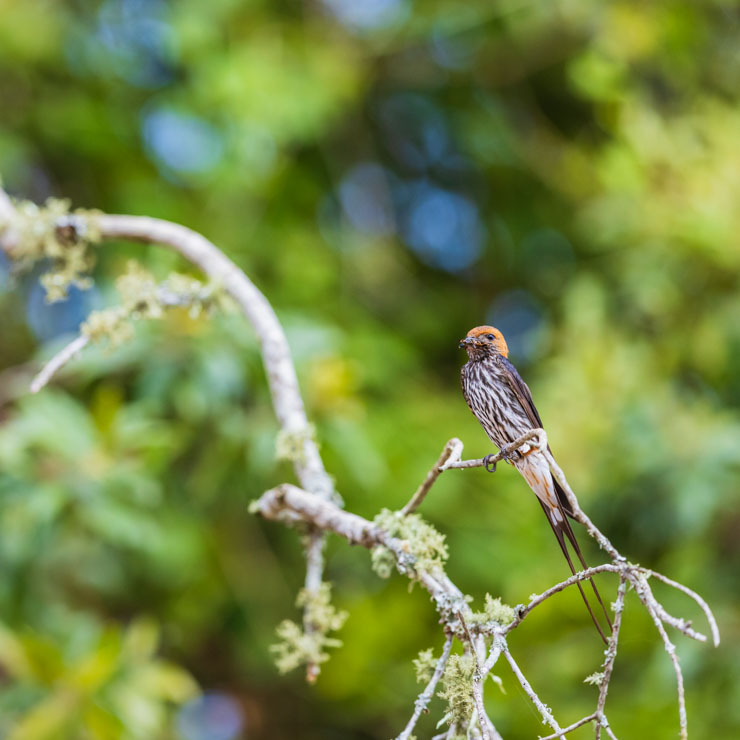
Lesser Striped Swallow
At this point there was not a single thought of any finfoot in any of my many minds. Of the three, there is only a single one on the continent, and from what I understood, it may as well be a single bird – such was the difficulty in seeing one. Luca, my colleague here at 10,000 Birds, mentioned that the African Finfoot was one of his favourite birds – which ultimately was never more than a fleeting sighting of “a splash of water as an orange foot disappeared into vegetation overhanging the water and our bird guide exclaiming “finfoot!”.” This was after living in South Africa, as I understand. I was merely preoccupied with not banging my head when I got onto the boat, thereafter shifting focus to keeping an eye on the hippos that were keeping eyes on us.
It didn’t take much time, however, to round the first bend slowly motoring past a Little Egret and Striated Heron who seemed to be begrudgingly sharing the same fishing area to then find ourselves drifting into a secluded, dead-end channel with what seemed to be an ever-increasing number of hippos. We eventually cut the engine and drifted near to a Malachite Kingfisher followed by a resting Nile Crocodile that we peered at through the reeds. Then the whispers of the finfoot variety began to circulate.
Was there one that was here some years ago? Showed well then and people got great photos? Please, show me the back-of-camera pictures on your cell phone. Oh nice, too big to fit in the frame, bravo then.
Apparently, there was indeed at least one African Finfoot on the other side of the channel. I was happy it was a small channel, else the bird surely would’ve been further away. Straining our eyes as we scoured the heavily forested bank, every leaf that twisted in an eddy of the wind made our muscles twitch. The shadows were deep, dark crevasses in the vista, and could potentially hide an elephant. But eventually came the words “there she is” – and there she was indeed: an African Finfoot in all her glory. Gliding silently along the edge of the water, thrusting her stout, orange-red bill forward to then have her body follow. The boat captain indicated to us that she was the much less flashy of the pair, we should see the male. I disagreed, and revelled in her undeniable beauty.
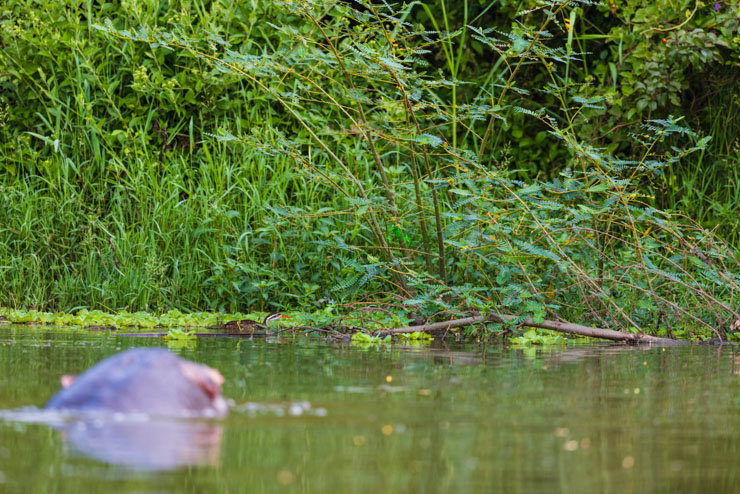
Our first glimpse of an African Finfoot, maybe that hippo in the foreground is a birder?
Our first glimpses involved trying to look around the hippos that were mock charging us. Eventually, the hippos lost interest and instead decided to remain in position but still glare at us as we ogled the bird.
It was fascinating to me how much like a Sungrebe this bird was. In addition to the similar markings of the female bird we were looking at, she glided across the surface of the water just as inconspicuously as her Neotropical cousin.
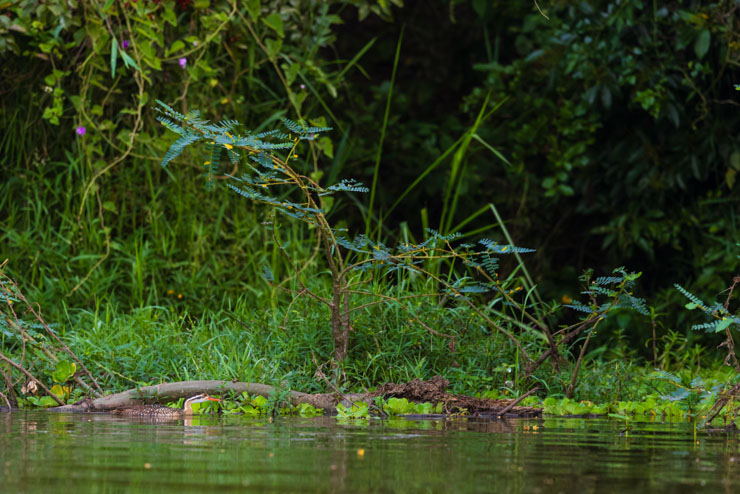
African Finfoot
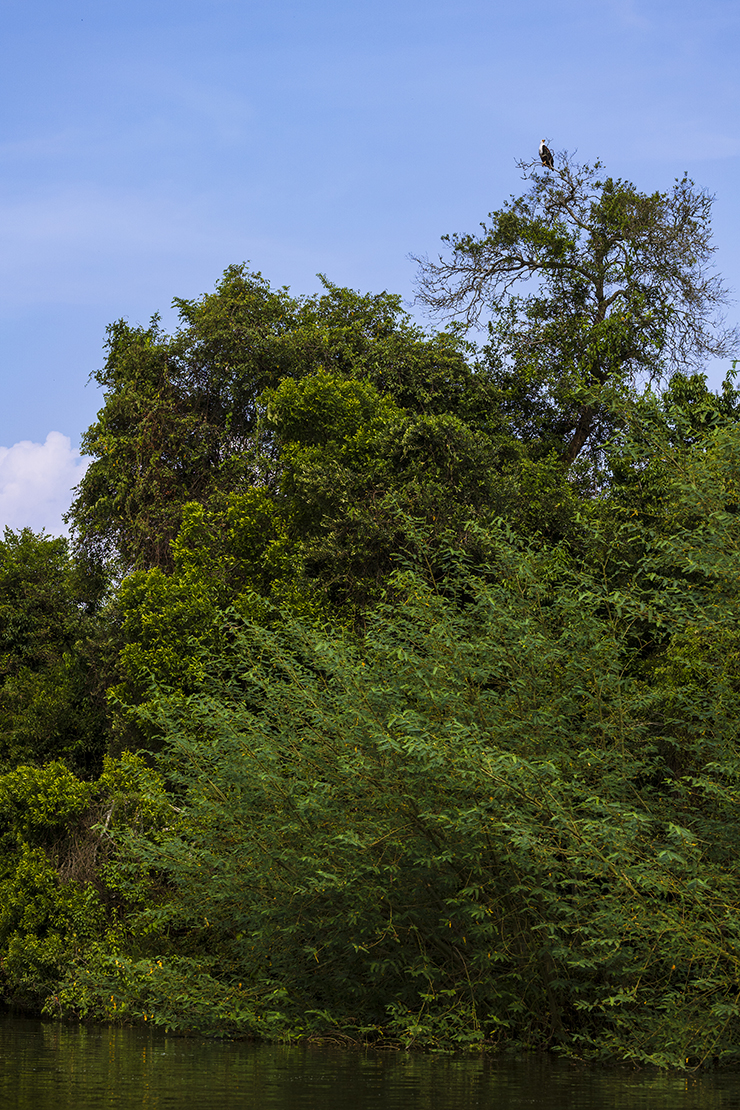
This African Fish-Eagle tried to distract us from our quest, but we were steadfast and not easily pulled from our purpose. (Grossly untrue statement, we get distracted by everything)
We were told that these are birds most often found in pairs – and as we waited patiently this fact was properly proven when a male African Finfoot emerged from the dark web of roots and branches. Despite what I was told, I still felt that the female was the flashier of the two. The greys and blacks of the male did make his bill look almost neon, though.

African Finfoot
I tried to make the best of the opportunities at the time; the bird was distant and rightfully so, as we did not want to risk a close approach that may result in the birds shooting for cover. It was much more rewarding to observe them from across the channel as they traversed the boundary line between open water and hanging vegetation. At one point there was a hippo in the way! No problem for a finfoot, it simply walked over the round, hulking top end of the beast and it was back in the water before I could switch from binoculars to camera.
Eventually, we let the finfoots be, and we moved on. Positively on a high from seeing one of the most difficult birds on the continent, I reclined in my seat and enjoyed the plethora of African Fish-Eagles of all ages that perched on almost every tall tree. There was even one that sat on a large enough piece of driftwood in the middle of the lake. Waterbucks and vervet monkeys lined the shore; everywhere we looked there were more hippos.
While exploring another nook in the shoreline, the captain curiously sent us directly into the vegetation. Were we going to moor ourselves here, was there another picnic? I wasn’t sure – but my hunch was that it could possibly be bird-related. And it was. Arguably an even tougher bird to find than the African Finfoot? Depends on the fortunes one has been dealt, of course. Nevertheless, we found ourselves staring at a White-backed Night Heron that was comfortably tucked away in a maze of twisted branches and twigs.
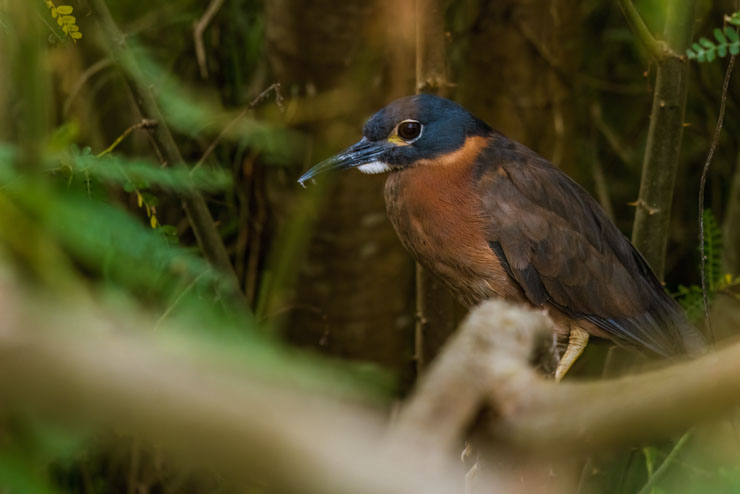
White-backed Night Heron, its white back invisible to us – and to most people in fact – as it is an inconspicuous feature of the bird, after which it has been named.
And if that wasn’t enough, as we raced back to the dock to escape the rapidly gathering storm clouds that loomed over the treeline, a minuscule movement near the lakeshore caught the eye of our captain. If our boat could have screeched to a halt, we would have. Another African Finfoot, this one caught clambering out of the water. We drifted closer, it climbed a bit higher. We pressed our eyes into our eyepieces and gazed at its intricate barring and delicate silvery spots. Not forgetting to mention those scarlet feet! The setting sun at our backs shone a spotlight on this reclusive creature which continued unbothered, as it should be, preening and stretching. Surely it was preparing for a long night of weathering the coming storm; we needed to do the same. And so, we departed – a fitting finale to a fantastic outing.
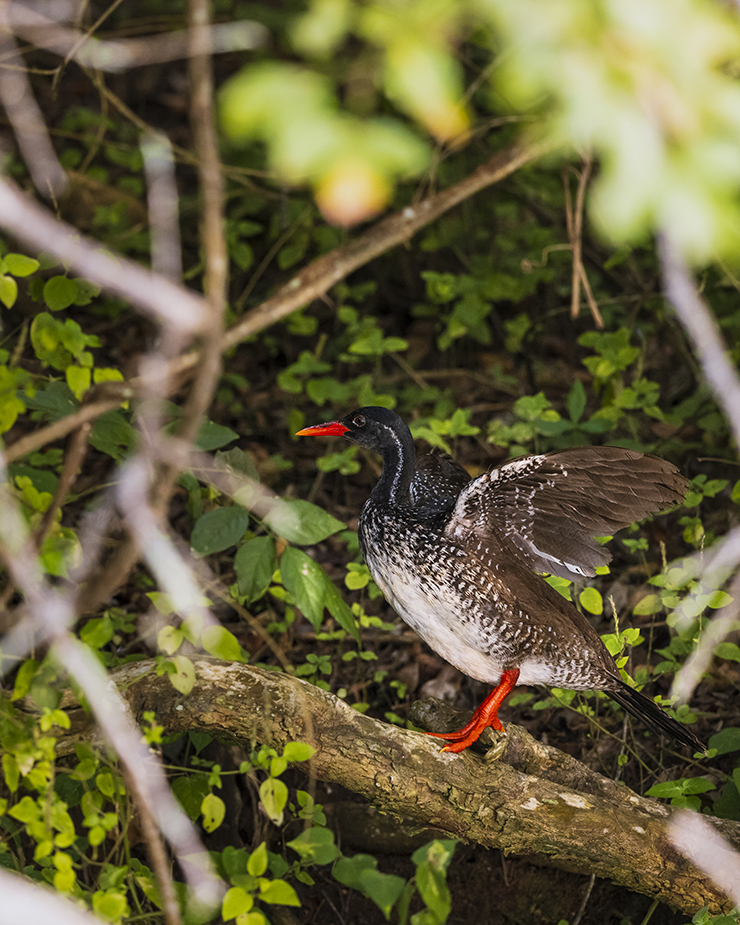
African Finfoot






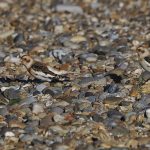
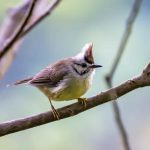
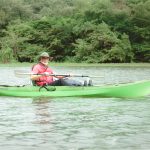

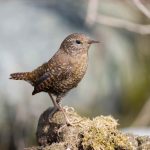
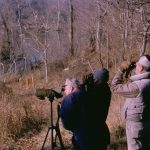
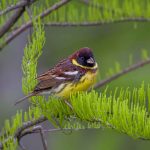
I think that the plural of finfoot is finfeet. Here in the UK we have big flocks of wintering pinkfeet (pinkfooted geese). Lake Mburo is a great site for finfeet: I had to check in my diary, but it reminded me that I saw five there in February 2008, though I didn’t get any photographs. I’ve also seen them in Zimbabwe and Kenya, including one in Nairobi National Park. Every sighting was a triumph!
In Malaysia I was lucky enough to see the third member of the family, the masked finfoot. It is an extraordinary-looking creature – my companion remarked that it was a real Donald Duck bird, which summed it up beautifully.
The plural of titmouse is titmouses because titmouse is NOT a derivation of mouse, but I am on the fence with finfeet. I’d rather prefer finfoot to be like sheep, one sheep, two sheep, three sheep, zzzzz…
I doubt I’ll ever see a Finfoot so I really enjoyed your great story. I also really liked your distant photos and agree, better distant than scaring the bird undercover. In the hippo in the frame and out of the frame photos, the bird is quite hard to find. When it’s such a special bird, these are some of my favorite kinds of photos. You scored a coup when you got the shot of the Finfoot on the log. You must have been thrilled. Check for one less bird in the family Nemesis.
A “nemesis family?…” Yes, I can absolutely confirm that.
I was in Uganda during the early covid-reopening period, some time around the start of 2021. Of course, I went by by bike to Lake Mburo. I was initially very disappointed when the gate agent told me that I wouldn’t be allowed in without a guide, but then my mood reversed when she mentioned that a ranger could guide me on a cycling visit. Woo hoo!
A while later, we arrived at the lake. I told the staff that I really wanted to see a Finfoot. But since I was the only visitor in the park, they replied that I’d have to buy all six seats on the boat or they wouldn’t take me out. i didn’t have enough cash on hand for that, after the unplanned hiring of the guide, so that was the end of that!
Visits to the other two continents where members from that family live also failed to see any Finfoot. *sighs*
Great article, Faraaz! I just returned from Uganda last week and my experience at Lake Mburo was very similar to yours. Floating among the hippos and watching the birdlife from a small boat is such a pleasant way to see everything.
We also saw a pair of Finfeet – I guess technically that would be two pairs of feet. It was such a fun way to see them – at eye level.
My first Finfoot sighting was in Kruger N.P. in South Africa. After six trips there over nine years – each time being told the best place was the Skukuza highbridge over the Sabie River – in 2019 on our last day just before driving to the airport, we took one last pass over the bridge and I looked down into the river below and there he was – swimming leisurely along the river bank under the overhanging shrubbery! I nearly jumped out the window and into the river! You are not allowed to get out of your car in Kruger (except in designated places) as you would be especially vulnerable to predators while being distracted by your first Finfoot sighting. Taking photos from inside the car is quite tricky and requires some deft manouvers such as driving all the way across the bridge to be able to turn around and then drive all the way back in order to have the Finfoot on my husband’s side of the car. The Finfoot could easily have disappeared under the bridge by the time we got back but he didn’t – he got out onto the rocks in the river and preened! One of my most fun sightings ever!
Your photo of the Finfoot out of the water with his wings up is terrific!
It looks like you got a little better view of the White-backed Night Heron than I did. I had a lot more sticks in the way, but it was still exciting to see.
I really enjoy your writing, Faraaz. I would love to hear more about your experiences in Uganda.
David – I remember reading your article where you mentioned that description and now I can’t ever unsee it. Fingers crossed I happen upon one of them someday!
Peter I’ll surely drive you crazy with my butchering of words if we ever go birding together. Some of my clients join in – let’s just say that this year was the year I learned that mongoose is actually the plural form of mongoo.
Oh yes when he climbed up on that log I couldn’t believe what I was seeing! It was a difficult photographic setting so I’m happy it was close enough. I’m glad you enjoyed the distant photos, I particularly enjoy creating those that showcase the bird’s habitat.
Michael – there must have been a conspiracy to keep you away! I hope you can find at least one of them sometime soon!
Hey thank you, Peggy! So happy to read your comment. Lake Mburo really was magical – it was only eclipsed by a cruise on the Kazinga Channel. I’ll write on that one too, but that’s a lot more mammals than birds so it may end up on my personal blog. Adhering to the rules of not getting out the vehicle really makes for some contortions, I’ve pulled many a muscle trying to bend some way I really shouldn’t be bending.
Another twist on the plural of “Finfoot” …the plural should be “Finfoots”. Why? Because bird names ignore the “correct” English grammar stuff and just take an ‘s.’ “Finfeet” would make it sound like we are counting toes, as opposed to spotting birds.
This also follows with Peter`s titmouse and titmouses.
Lake Mburo is mad for them. I got 20 in a single boat trip on that lake in 2004. Considering how absolutely mega they are anywhere else they are in Africa it’s amazing! Also a great park.